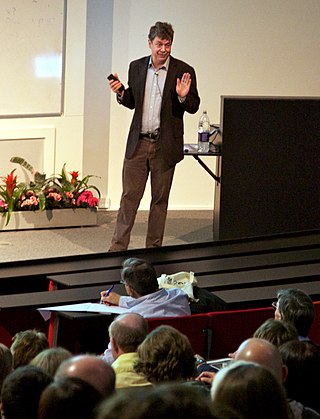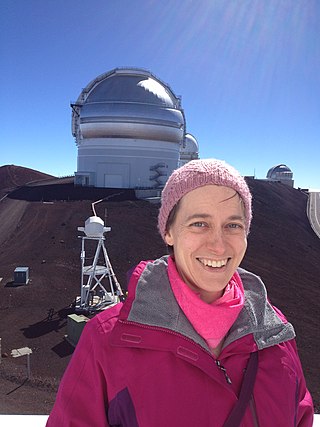Related Research Articles

An astronomer is a scientist in the field of astronomy who focuses their studies on a specific question or field outside the scope of Earth. They observe astronomical objects such as stars, planets, moons, comets and galaxies – in either observational or theoretical astronomy. Examples of topics or fields astronomers study include planetary science, solar astronomy, the origin or evolution of stars, or the formation of galaxies. A related but distinct subject is physical cosmology, which studies the Universe as a whole.

Sandra Moore Faber is an American astrophysicist known for her research on the evolution of galaxies. She is the University Professor of Astronomy and Astrophysics at the University of California, Santa Cruz, and works at the Lick Observatory. She has made discoveries linking the brightness of galaxies to the speed of stars within them and was the co-discoverer of the Faber–Jackson relation. Faber was also instrumental in designing the Keck telescopes in Hawaii.

Astrophysics is a science that employs the methods and principles of physics and chemistry in the study of astronomical objects and phenomena. As one of the founders of the discipline, James Keeler, said, astrophysics "seeks to ascertain the nature of the heavenly bodies, rather than their positions or motions in space–what they are, rather than where they are." Among the subjects studied are the Sun, other stars, galaxies, extrasolar planets, the interstellar medium and the cosmic microwave background. Emissions from these objects are examined across all parts of the electromagnetic spectrum, and the properties examined include luminosity, density, temperature, and chemical composition. Because astrophysics is a very broad subject, astrophysicists apply concepts and methods from many disciplines of physics, including classical mechanics, electromagnetism, statistical mechanics, thermodynamics, quantum mechanics, relativity, nuclear and particle physics, and atomic and molecular physics.
Annette Mairi Nelson Ferguson FRSE is a Scottish observational astrophysicist who specialises in the area of galaxy evolution. She is a professor at the Institute for Astronomy, Edinburgh, and holds the Personal Chair in Observational Astrophysics at the School of Physics and Astronomy, University of Edinburgh.
The Dannie Heineman Prize for Astrophysics is jointly awarded each year by the American Astronomical Society and American Institute of Physics for outstanding work in astrophysics. It is funded by the Heineman Foundation in honour of Dannie Heineman.
Robert Charles Kennicutt, Jr. FRS is an American astronomer. He is currently a professor at Texas A&M University. He is a former Plumian Professor of Astronomy at the Institute of Astronomy in the University of Cambridge. He was formerly Editor-in-Chief of the Astrophysical Journal (1999–2006) and became a co-editor of the Annual Review of Astronomy and Astrophysics as of 2021. His research interests include the structure and evolution of galaxies and star formation in galaxies.
Marc Davis is an American professor of astronomy and physics at the University of California, Berkeley. Davis received his bachelor's degree from the Massachusetts Institute of Technology in 1969, his Ph.D from Princeton University in 1973 and has been elected to both the National Academy of Sciences (1991) and the American Academy of Arts and Sciences (1992). He taught for a year at Princeton, 1973–74, then was on the astronomy faculty at Harvard from 1975 to 1981. Since 1981, he has been on the faculty of the Department of Astronomy and Physics at the University of California at Berkeley.
Lisa Jennifer Kewley is an Australian Astrophysicist and current Director of the Center for Astrophysics | Harvard & Smithsonian. Previously, Kewley was Director of the ARC Centre of Excellence for All Sky Astrophysics in 3-D and ARC Laureate Fellow at the Australian National University College of Physical and Mathematical Sciences, where she was also a Professor. Specialising in galaxy evolution, she won the Annie Jump Cannon Award in Astronomy in 2005 for her studies of oxygen in galaxies, and the Newton Lacy Pierce Prize in Astronomy in 2008. In 2014 she was elected a fellow of the Australian Academy of Science. In 2020 she received the James Craig Watson Medal. In 2021 she was elected as an international member of the National Academy of Sciences. In 2022 she became the first female director of the Center for Astrophysics | Harvard & Smithsonian.

Kenneth Charles Freeman is an Australian astronomer and astrophysicist who is currently Duffield Professor of Astronomy in the Research School of Astronomy and Astrophysics at the Mount Stromlo Observatory of the Australian National University in Canberra. He was born in Perth, Western Australia in 1940, studied mathematics and physics at the University of Western Australia, and graduated with first class honours in applied mathematics in 1962. He then went to Cambridge University for postgraduate work in theoretical astrophysics with Leon Mestel and Donald Lynden-Bell, and completed his doctorate in 1965. Following a postdoctoral appointment at the University of Texas with Gérard de Vaucouleurs, and a research fellowship at Trinity College, Cambridge, he returned to Australia in 1967 as a Queen Elizabeth Fellow at Mount Stromlo. Apart from a year in the Kapteyn Institute in Groningen in 1976 and some occasional absences overseas, he has been at Mount Stromlo ever since.

Roger David Blandford, FRS, FRAS is a British theoretical astrophysicist, best known for his work on black holes.

Simon David Manton White, FRS, is a British-German astrophysicist. He was one of directors at the Max Planck Institute for Astrophysics before his retirement in late 2019.
The Santa Cruz Institute for Particle Physics (SCIPP) is an organized research unit within the University of California system focused on theoretical and experimental high-energy physics and astrophysics.
Lennox Lauchlan Cowie FRS is a British astronomer, and professor at the Institute for Astronomy, University of Hawaiʻi.

Wendy Laurel Freedman is a Canadian-American astronomer, best known for her measurement of the Hubble constant, and as director of the Carnegie Observatories in Pasadena, California, and Las Campanas, Chile. She is now the John & Marion Sullivan University Professor of Astronomy and Astrophysics at the University of Chicago. Her principal research interests are in observational cosmology, focusing on measuring both the current and past expansion rates of the universe, and on characterizing the nature of dark energy.

Claudia Megan Urry is an American astrophysicist, who has served as the President of the American Astronomical Society, as chair of the Department of Physics at Yale University, and as part of the Hubble Space Telescope faculty. She is currently the Israel Munson Professor of Physics and Astronomy at Yale University and Director of the Yale Center for Astronomy and Astrophysics. Urry is notable not only for her contributions to astronomy and astrophysics, including work on black holes and multiwavelength surveys, but also for her work addressing sexism and sex equality in astronomy, science, and academia more generally.

Chryssa Kouveliotou is a Greek astrophysicist. She is a professor at George Washington University and a retired senior technologist in high-energy astrophysics at NASA's Marshall Space Flight Center in Huntsville, Alabama.

Vassiliki Kalogera is a Greek astrophysicist. She is a professor at Northwestern University and the director of the Center for Interdisciplinary Exploration and Research in Astrophysics (CIERA). She is a leading member of the LIGO Collaboration that observed gravitational waves in 2015.
Richard Alan McCray was an American astronomer and astrophysicist.

Pauline Barmby is a Canadian astronomer currently based at the University of Western Ontario. She studies galaxies, their formation and evolution from an observational standpoint. She studies both nearby galaxies and those at high redshift using telescopes like the Spitzer Space Telescope. She is the co-chair, with Bryan Gaensler, of the Canadian Astronomy 2020 Long Range Plan.
Alyson Brooks is an American theoretical astrophysicist and professor at Rutgers University. She uses large-scale simulations to determine how galaxies form.
References
- ↑ "WIA Report on Downsbrough Chair". wiareport.com. Retrieved 2012-04-23.
- ↑ Astrophysicist Rachel Somerville Wins 2013 Dannie Heineman Prize for Astrophysics, 2013-01-23, archived from the original on 2013-09-01, retrieved 2013-09-10
- ↑ "Rutgers biography of Rachel Somerville". rutgers.edu. Retrieved 2012-04-23.
- ↑ "A Conversation with Theoretical Astrophysicist, Rachel Somerville". 2013-08-30. Retrieved 2013-09-10.
- ↑ "Article on Rachel Somerville's computer modeling". PhysOrg. 2013-01-24. Retrieved 2013-11-04.